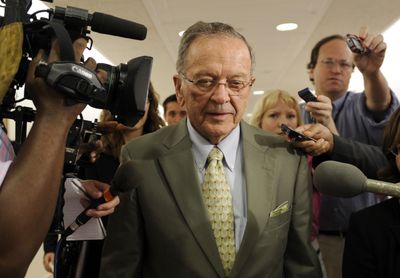Alaskans ponder impact of Stevens indictment

ANCHORAGE, Alaska – Alaska’s vast landscape is littered with federally funded tributes to Sen. Ted Stevens’ single-minded promotion of the state, from the brushed steel of Ted Stevens Anchorage International Airport to the $187 million that subsidizes air mail for the one-third of residents who live beyond the reach of roads.
In his almost 40 years in the Senate, the octogenarian Republican in many ways defined the shape of the Last Frontier, not least by using his perch on the Appropriations Committee to ensure that his state’s tiny population remained the nation’s richest in per-capita federal spending. More than $9 billion arrived in Alaska from Washington in 2006, twice as much as a decade earlier.
So it was perhaps to be expected that many here greeted the news of Stevens’ indictment on corruption charges as if they were condemned to a pauper’s death, fearful that they will no longer be able to depend on the largess of “Uncle Ted.”
“There’s no good that will come of this,” said Jim Whitaker, a Republican who quit the state legislature to combat the corrupt oil services company whose taint threatens to bring down Stevens. “For those of us who’ve been involved with politics in Alaska, one of the paradigms that we counted on in terms of funding public policy was the capability of Ted Stevens.
“It’s not as though we don’t have the capability to take care of ourselves,” said Whitaker, now the mayor of Fairbanks’s North Star Borough. “My concern is we’re not used to it.”
A third of Alaska’s jobs can be traced to federal spending, according to the latest study by the University of Alaska’s Institute of Social and Economic Research. Many spring from military expenditures that Stevens encouraged during decades of service on the appropriations subcommittee that oversees defense spending.
“If he leaves the Appropriations Committee, how long do they leave the Stryker brigade here?” asked Mike Doogan, a Democratic state representative from Anchorage. “There are a lot of things that are attributable to him that are likely to dry up.”
The watchdog group Taxpayers for Common Sense said on Wednesday that Stevens secured or played a significant role in 891 earmarks worth $3.2 billion to Alaska between 2004 and 2008. Divided among the state’s 670,000 residents, the per-capita figure of $4,872 is 18 times greater than the national average of $263 over the same four years, the group said.
In Alaska, that amounts to a great deal of goodwill. Unlike the state’s sole representative, Republican Don Young, author of the “Bridge to Nowhere” earmark and also a target of a federal investigation, Stevens long has been viewed as a statesman, interested above all in the state he helped found half a century ago, when he lobbied for statehood.
Some here point to a 1991 bill that settled the land claims of the state’s indigenous population by establishing not reservations, but corporations. Thirteen “native corporations” were each given millions of acres and millions of dollars.
Stevens, clearly driven by the need to establish who owned the land atop which a new oil pipeline would be built, framed the bill and pushed it through Congress. But natives emphasize that Stevens nurtured the corporations through rough beginnings. Many invested so shrewdly that 2006 revenue reached $5.3 billion.
“What’s exciting is these corporations are reversing this long historic trend of extracting resources and sending profits outside the state. We are in fact in the business of importing profits,” said Margie Brown, chief executive of the Cook Inlet Region Inc.
“Ted Stevens was there at the beginning, the author of this act,” Brown said. “He feels he has a stake in how this turns out.”